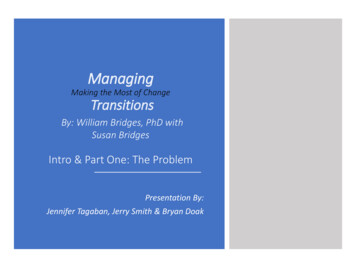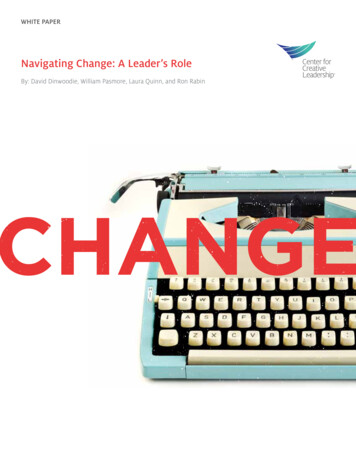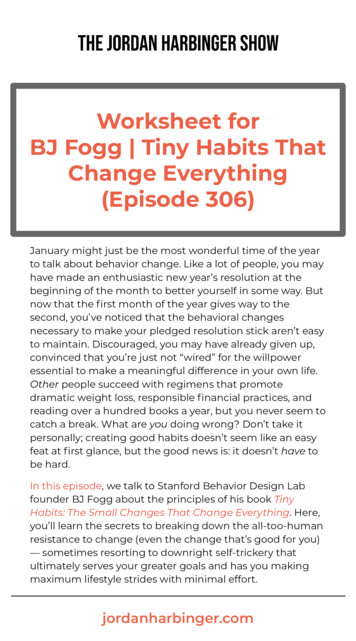
Transcription
ManagingMaking the Most of ChangeTransitionsBy: William Bridges, PhD withSusan BridgesIntro & Part One: The ProblemPresentation By:Jennifer Tagaban, Jerry Smith & Bryan Doak
Introduction12Advancement in technologyhas led to undeniablechanges within workorganizations.Success of transitions duringsuch changes lies in theability to get people to stopdoing things the old way andget them to do things thenew way.3Keys of transitionmanagement: Maintaining personal connectionsbetween employees and theorganization Acknowledging the impact thechange has on employees
Change vs.Transition“It’s not the changes that do you in, it’s thetransitions.”–William Bridges, p. 3Change: Something in the external environmentchanges Situational and happens without peopletransitioning Change is fastTransition: A three phase psychological process people gothrough to come to terms with a new situation Is required in order for change to besuccessfully implemented Transition is slow
The Three Phases of TransitionTransition PhaseEndings/Letting GoWhat’s HappeningEmotional upheaval, fear,denial, anger, a sense of loss,resistance.Neutral ZoneConfusion and possibleresentment towards change.Low morale and productivity.Opportunity for innovation andingenuity.The new situation is accepted.People are committed to newways. Energy is high and there isa sense of purpose.BeginningsFigure 1.1, page 5How to Make the Change WorkExpect and accept a variety ofemotions, communicate fluidly,clearly define what is over andwhat is not.Offer guidance and direction,share success stories, givefeedback on performance,support team work andownership.Align personal goals withorganizational goals, createopportunities for success, painta picture of the future.
Interventions to r change–Identify &understand whowill lose what3–Sell theproblem4567–Get employeesin touch withclients–Talk to employeesand ask whatproblems they havewith the change–Talk about thetransition and letpeople know it’shuman to feel–Hold regularteam meetingseven before thechangep. 18
DO:Dos and Don’tsof ManagingTransitions Determine exactly whatchanges in existing behaviorand attitudes will need tohappen Ask individuals the rightquestions to find out thetrue problems Hold regular team meetingstalk about the transition Ensure everyone is aware ofthe problems that are inneed of change Implement temporarysystems during neutral zone Use ambiguity tocontinuously improve Physically make groupworkspace changesDON’T: Explain change through amemo or org chart Turn change over to anindividual contributor and askthem to develop the wholeplan Break change into smallerstages Pull a model team togetherto show others how Make threatsp.19-23
ManagingMaking the Most of ChangeTransitionsBy: William Bridges, PhD withSusan BridgesPart Two: The SolutionPresentation By:Linda Elliott-Nelson, Peggy Locklear, & Travis Mitchell
LetItGoTransitions require changes that bring about endings, which nobodylikesChanges to protocols, teams, environments, and chains ofcommand make things unfamiliar and uncomfortableIt’s not necessarily the changes themselves, but thefeeling of loss and the ‘Neutral Zone’ that they resistTry to understand who is losing what, and why it mattersto them– including secondary and tertiary effects (andlosses)There will be overreaction from those who feel they weretreated unfairly previously, who are feeling a larger symbolicloss, or who feel unvaluedAcknowledge the loss. Expect the six stages of grief:Anger, Bargaining, Anxiety, Sadness, Disorientation, and Depression
CommunicationThePast Communicate what is being left behind Be specific Create actions or activities thatdramatize the past Do not be critical of the past Honor the past for its accomplishments Create a “Wall of Fame”TheFuture Do not be secretive Utilize various communicationmethods; for example, large meetings,one-on-ones, email, website stories,and Facebook Do not assume that informationtrickled down from the top Release information as it becomesavailable
During this time: Anxiety rises There are mixed signals People become polarizedBUT, it is also a creative timeNeutralZone between the old ways and the newways Actions “Normalize” the neutral zone Time for reorientation and redefinition Create temporary systems with checkpointsand short range Strengthen intragroup connections Use transition monitoring team Time to step back and take stock Encourage learning in discovery andinnovation Look for opportunities
ManagingMaking the Most of ChangeTransitionsBy: William Bridges, PhD withSusan BridgesPart II: The Solution IILaunching a New Beginning &Transition,Development, and RenewalPresentation By: Angie Creel & Steve Moore
Introduction1Beginnings versus Starts:Beginnings mark the birthof a new entity, whereasStarts are less complexand illustrate differencesin the established norms2Transitions: Change Process3Development: Cycle ofGrowth4Renewal : Re-Dream or Die
Beginnings vs.StartsBeginnings are “expression of a new identity”–William Bridges, p. 65Beginnings: Beginnings can both cause anxieties andexcitement for positive change. It is the attitudes, feelings, connections withprevious people and supervisors, that make uptrue beginnings.Starts: Starts, are less complex and are simply thepoint at which things are different.
Actions that can help are:Beginningsmust be“encouraged,supported, andreinforced”Bridges, p. 68 Have a clearPURPOSE for the newbeginning.Communicate it. Paint a PICTURE ofwhat the end resultwill be. Let peopleenvision the goal. Devise a PLAN to getto where you’d like tobe. Communicate aclear path of action. Give each participanta PART to play anddescribe how it fitswith the wholepicture.
BeEnsureRule 1: Be ConsistentRule 2: Ensure Quick SuccessesReinforcingthe"New Beginning"Symbolize Rule 3: Symbolize the New IdentityCelebrate Rule 4: Celebrate the Success
“a mature business orone that is approachingthe end of its life” –William Bridges, p. 87Phases of Transition, Development, and RenewalSeven Stages of Organizational LifeOrganizational Life PhaseDreaming the DreamWhat’s HappeningConceptualizing and PlanningHow to Make the Change WorkBrainstorm and ArgueLaunching The VentureLearn to ImproviseGetting OrganizedOrganizational Infancy andChildhoodOrder From ChaosMaking ItOrganizational AdulthoodBecoming An InstitutionDoing To Being: OrganizationalAchievements to ExternalImpressionsEnd of Vital Tension Betweenthe Organization and itsEnvironmentThe End of the Life CycleMaking eVentureClosing InDreamingTheDreamClosing InDyingDyingFigure 6.1, page 89Roles are Specialized andDefinedFundamental Nature ofOrganization ContinuesReputation is Established andNo Longer Earned.Internal Focus SupersedesExternal Priorities.Self-Fulfilling Demise
“development originallymeant –out of an initialseen dream as surely as anoak unfolds out of anacorn”- William Bridges, p. 102Phases of Transition, Development, and RenewalOrganizational RenewalOrganizational Life Phase What’s HappeningDreaming the Dream4:Succeeding,Making It5BecomingAnInstitutionLaunching The Venture6B: ClosingInGetting Organized6 A: ThePath ofRenewal3:7B: Closing InGettingOrganized7A:BeginningAnew2:Making It5: Becoming AnInstitution6A: The Path of Renewal6B: Closing InLaunchingthe Venture1:DreamingThe Dream7B: Closing In7A: Beginning AnewDreaming the DreamFigure 6.2, page 99Conceptualizing andPlanningOrganizational Infancyand ChildhoodOrder From ChaosHow to Make the ChangeWorkRe-Dream The DreamRecapture the VentureSpritRemodel the policies,roles and structures of ayoung organizationOrganizational Adulthood Let Go and Move OnDoing To Being:Get Used to Life in theOrganizationalNeutral ZoneAchievements to ExternalImpressionsEmbodiment of newLive in the now as theBehaviors and Attitudes Institution moves to theTomorrow . Jump to 7 AOR DIEEnd of Vital TensionInternal FocusBetween theSupersedes ExternalOrganization and itsPriorities.EnvironmentDieConceptualizing andRe-Dream The DreamPlanning
Transitions and Renewal:A ChecklistYesNoUnderstand the seven stages of the organizational life cycle?Distinguish between details of organization’s situation?Identify the original dream that represented the first stage?Explain characteristics of Venture developmental stage?Understand difference between everyday efforts be more organized and developmental stage called “Getting Organized”?Explain the new concerns and attitudes that develop as an organization moves from making it to becoming an institution?Identify where the organization is in its own cycle?Understand the “moment of truth” of an organization- time when it must make a choice that will determine if it’ll survive?Know the three transition-based questions to ask when planning how the organization can move through a transformative time?p.106-107
ManagingMaking the Most of ChangeTransitionsBy: William Bridges, PhD withSusan BridgesPart III: Dealing with Nonstop Change in theOrganization and in Your LifePresentation By: Jana Moore & Kari Gardner
The Three Phases of ChangeHave an Ending, Neutral Zone andNew BeginningHowever You are likely to be in more than one phase at thesame time. There are likely to be multiple changes overlapping.
Look forPatterns andOrchestrateResponses The organization’s history is a life history andchange is moving from one chapter to the next. Connect the dots (of the changes) and createresponses to changes based on the overallpatterns. Strive for a clear picture of the overarchingchange in the midst of lots of smaller changes.
Managing Multiple Changes12Postpone extrachangesIdentify &understand whowill lose what3Do worst-casescenarios4Make thetransition to“change as thenorm”5Clarify yourpurpose6Rebuild trustand unload oldbaggage7Sell problems,not solutions
The Cycle ofChallenge andResponse Create creativesolutions to ongoingproblems. Create a culture ofresponding tochallenges andembracing change Develop this culture ofresponding at everylevel of the organization Create a sense ofpurpose and control byencouraging creativeresponsesIncrease theorganization’stransitionworthiness
ManagingMaking the Most of ChangeTransitionsBy: William Bridges, PhD withSusan BridgesPart 4: The ConclusionPresentation By:Wendy Hoag & Sandra Rodriguez
Why should we managetransitions? Our moral responsibility is not to stop the future,but to shape it to channel our destiny inhumane directions and to ease the trauma oftransition.Alvin Toffler,American Futurist
G.R.A.S.S.GuiltThose who shaped thechange, and those impactedby the change.Resentment“ yesterday’s changes leavea legacy of resentment,today’s changes areundermined before they arelaunched.”AnxietyStifles innovation andmotivation.UnmanagedTransitionsSelf-Absorption Causes people to focus ontheir own concerns and notthe concerns of others.StressAffects health and safety.
Tips forManagingTransitionsTakeTake care of things that need immediateattention.StartStart planning things that will take time.PlanPlan things appropriately.Don’twasteDon’t waste your time on things that may havelittle benefit.KnowKnow which things you shouldn’t do.
Managing Making the Most of Change Transitions By: William Bridges, PhD with Susan Bridges Part II: The Solution II Launching a New Beginning &Transition, Development, a










